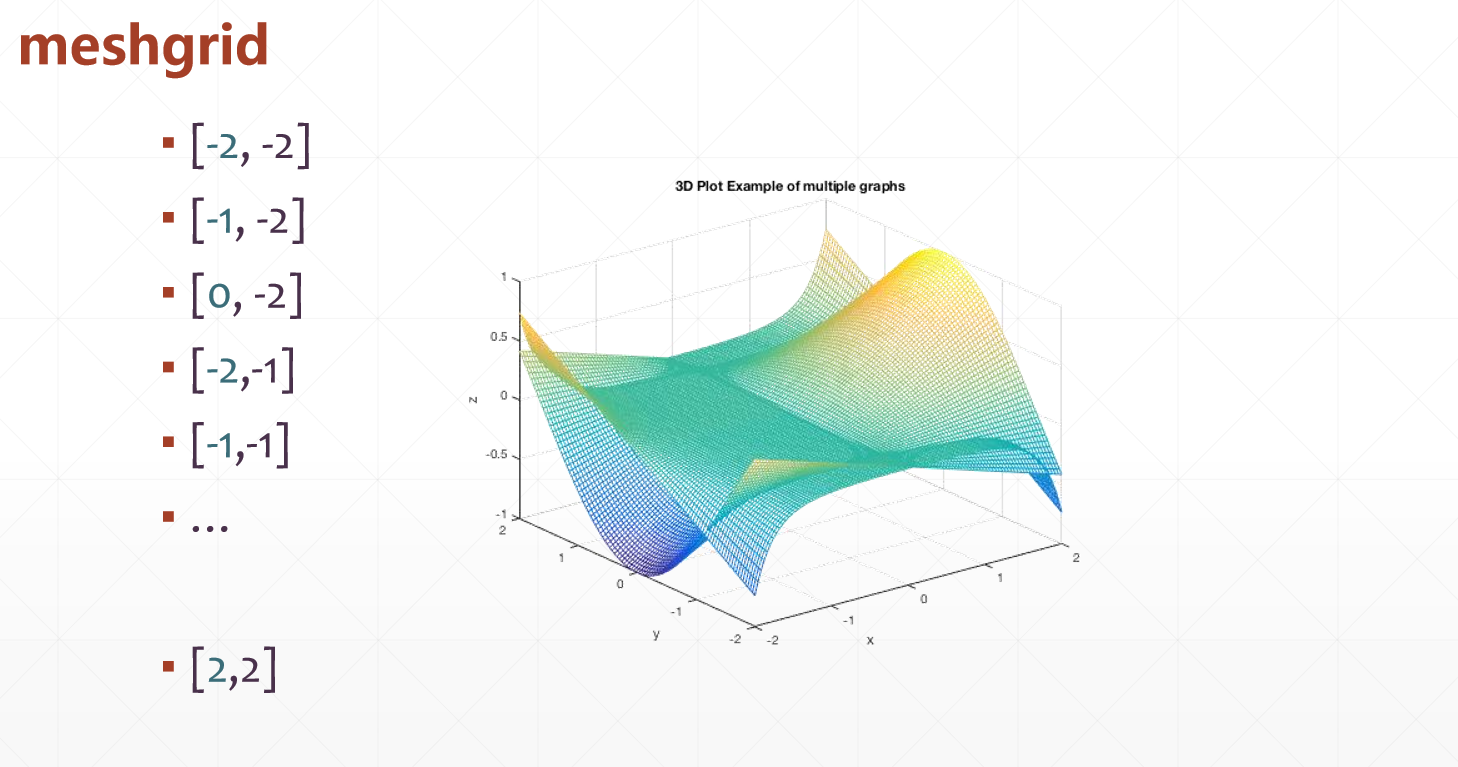12、高阶op操作
- where 得到mask中的Ture在原张量中的位置,根据坐标系根据条件需求(a>0)有目的的选择
- scatter_nd 根据坐标有目的性的更新
- meshgrid 生成数据点(x,y)
1、where ,得到mask在Ture在a对应的元素的位置坐标,然后通过gather进行收集
(1) where(Tensor),只接收一个参数,这个Tensor是一个bool型,里面的元素是Ture or False,返回Ture元素所有的坐标
a = tf.random.normal([3,3]) print(a) mask = a>0 #生成一个bool型的张量 print(mask) #①第一种方式 b = tf.boolean_mask(a,mask) #在a中取出mask中对应的Ture的值 print(b)
#②第二种方式,两种方式的结果一样 indices = tf.where(mask) #得到mask中Ture在a对应的元素的位置坐标,然后通过gather进行收集 print(">>>>>indices:",indices) b = tf.gather(a,indices) # gather是进行维度收集 print(">>>>>>>>",b) b = tf.gather_nd(a,indices) # gather_nd进行元素收集 print(">>>>>>",b)
输出:
tf.Tensor( [[ 0.48391852 1.4074458 1.0196995 ] [ 0.6496246 -1.8962317 -0.80803776] [ 1.3511435 -0.717642 0.7378417 ]], shape=(3, 3), dtype=float32) tf.Tensor( [[ True True True] [ True False False] [ True False True]], shape=(3, 3), dtype=bool) tf.Tensor([0.48391852 1.4074458 1.0196995 0.6496246 1.3511435 0.7378417 ], shape=(6,), dtype=float32) >>>>>indices: tf.Tensor( [[0 0] [0 1] [0 2] [1 0] [2 0] [2 2]], shape=(6, 2), dtype=int64) >>>>>>>> tf.Tensor( [[[ 0.48391852 1.4074458 1.0196995 ] [ 0.48391852 1.4074458 1.0196995 ]] [[ 0.48391852 1.4074458 1.0196995 ] [ 0.6496246 -1.8962317 -0.80803776]] [[ 0.48391852 1.4074458 1.0196995 ] [ 1.3511435 -0.717642 0.7378417 ]] [[ 0.6496246 -1.8962317 -0.80803776] [ 0.48391852 1.4074458 1.0196995 ]] [[ 1.3511435 -0.717642 0.7378417 ] [ 0.48391852 1.4074458 1.0196995 ]] [[ 1.3511435 -0.717642 0.7378417 ] [ 1.3511435 -0.717642 0.7378417 ]]], shape=(6, 2, 3), dtype=float32) >>>>>> tf.Tensor([0.48391852 1.4074458 1.0196995 0.6496246 1.3511435 0.7378417 ], shape=(6,), dtype=float32)
(2) where(mask,A,B),接收三个参数
在mask中,如果是Ture的,则在A中选对应的元素,如果是False的,则在B中选对应的元素
1 a = tf.random.normal([3,3]) 2 print(a) 3 4 mask = a>0 #生成一个bool型的张量 5 print(mask) 6 7 A = tf.ones([3,3]) 8 B = tf.fill([3,3],4.0) 9 b = tf.where(mask,A,B) 10 print(b)
输出:
tf.Tensor( [[ 1.5847638 -1.4374838 -0.96571 ] [ 0.6690132 0.69762254 1.6966511 ] [ 0.47084153 -0.22469759 1.0512805 ]], shape=(3, 3), dtype=float32)
tf.Tensor( [[ True False False] [ True True True] [ True False True]], shape=(3, 3), dtype=bool)
tf.Tensor( [[1. 4. 4.] [1. 1. 1.] [1. 4. 1.]], shape=(3, 3), dtype=float32)
2、scatter_nd
(1)tf.scatter_nd(indices,updates,shape) 根据indices坐标将updates的值更新到底板shape的张量中
- indices 坐标
- updates 更新
- shape 形状
(2)a是一个shape为8的全0值的tensor,scatter_nd将updates中的数据按照indices中的位置坐标更新到shape为8的a张量中

代码:
①一维张量
1 indices = tf.constant([[4],[3],[1],[7]]) 2 updates = tf.constant([9,10,11,12]) 3 shape = tf.constant([8]) 4 5 a = tf.scatter_nd(indices,updates,shape) 6 print(a) #tf.Tensor([ 0 11 0 10 9 0 0 12], shape=(8,), dtype=int32)
②多维张量,在第0个位置和第2个位置更新
1 indices = tf.constant([[0],[2]]) 2 updates = tf.constant([[[5,5,5,5],[6,6,6,6],[7,7,7,7],[8,8,8,8]], 3 [[5,5,5,5],[6,6,6,6],[7,7,7,7],[8,8,8,8]]]) 4 shape = tf.constant([4,4,4]) 5 a = tf.scatter_nd(indices,updates,shape) 6 print(a)
输出:
tf.Tensor( [[[5 5 5 5] [6 6 6 6] [7 7 7 7] [8 8 8 8]] [[0 0 0 0] [0 0 0 0] [0 0 0 0] [0 0 0 0]] [[5 5 5 5] [6 6 6 6] [7 7 7 7] [8 8 8 8]] [[0 0 0 0] [0 0 0 0] [0 0 0 0] [0 0 0 0]]], shape=(4, 4, 4), dtype=int32)
3、meshgrid
(1) 用于三维曲面的分割线坐标,产生格点矩阵,生成一个图片,z=z(x,y)

(2)np.linspace(-2,2,5)生成范围为-2到2的5个点
(3)meshgrid(x,y)相当于将一个坐标拆分保存到两个Tensor中
#生成点的两种方式
1 def creatPoints1(): #两个循环 2 points = [] 3 for x in np.linspace(-2,2,5): 4 for y in np.linspace(-2,2,5): 5 points.append([x,y]) 6 return np.array(points) 7 8 def creatPoints2(): 9 x = tf.linspace(-2.,2,5) #tf要设置成浮点型的数据 10 y = tf.linspace(-2.,2,5) 11 points_x, points_y = tf.meshgrid(x,y) #相当于将一个坐标拆分保存到两个Tensor中 12 print(x) 13 print(y) 14 print(points_x) 15 print(points_y) 16 points = tf.stack([points_x,points_y],axis=2) 17 print(points) # shape=(5, 5, 2) 18 19 20 if __name__ == '__main__': 21 creatPoints2()
输出:
tf.Tensor([-2. -1. 0. 1. 2.], shape=(5,), dtype=float32) tf.Tensor([-2. -1. 0. 1. 2.], shape=(5,), dtype=float32) tf.Tensor( [[-2. -1. 0. 1. 2.] [-2. -1. 0. 1. 2.] [-2. -1. 0. 1. 2.] [-2. -1. 0. 1. 2.] [-2. -1. 0. 1. 2.]], shape=(5, 5), dtype=float32) tf.Tensor( [[-2. -2. -2. -2. -2.] [-1. -1. -1. -1. -1.] [ 0. 0. 0. 0. 0.] [ 1. 1. 1. 1. 1.] [ 2. 2. 2. 2. 2.]], shape=(5, 5), dtype=float32) tf.Tensor( [[[-2. -2.] [-1. -2.] [ 0. -2.] [ 1. -2.] [ 2. -2.]] [[-2. -1.] [-1. -1.] [ 0. -1.] [ 1. -1.] [ 2. -1.]] [[-2. 0.] [-1. 0.] [ 0. 0.] [ 1. 0.] [ 2. 0.]] [[-2. 1.] [-1. 1.] [ 0. 1.] [ 1. 1.] [ 2. 1.]] [[-2. 2.] [-1. 2.] [ 0. 2.] [ 1. 2.] [ 2. 2.]]], shape=(5, 5, 2), dtype=float32)

 浙公网安备 33010602011771号
浙公网安备 33010602011771号